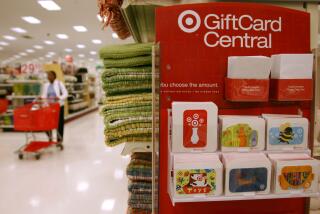True to Life
- Share via
Know someone who was stood up at the altar? Someone who is dying of AIDS, cancer or is taking care of someone dying of AIDS or cancer? Someone whose pet has died, or who was downsized at work, has come out of the closet, had a miscarriage or reentered a 12-step program?
No problem. The 1,500 greeting card publishers in America are right on your tail. The $6.9-billion-a-year industry, which peddles 7.5 billion cards per year, knows its job is to find out what’s going in your life. Forget roses-are-red verses. Now irreverent sentiments such as “Aren’t birthdays a bitch?”--from companies like Marcel Schurman in New York--are increasingly popular.
Where else could you get as representative a painted tableau of American life in the mid-’90s? “Cards reflect things faster,” says Marianne McDermott, executive vice president of the Greeting Card Assn. in Washington. “They’re cheap, high turnover snapshots of the way we are.”
Today, hundreds of small Davids fight Hallmark’s Goliath to show us those snapshots, including many fine-art photographers and artists who view cards as the new gallery wall space. “Wall space in the art world is tough to get,” says Duana Whitehead, a Los Angeles photographer. “A greeting card does two things: It gets your images out in the world and gets you great exposure. And it’s a cheap way to do it.”
“Today, people can’t afford thousands of dollars for a painting,” says Constance Kay, whose New York company, A Little Piece of Art, sells original artwork cards from $2 to $200. “But they can afford $10. That’s not bad for an authentic, hand-done piece of art.” Indeed, the days of the 75 cent card are over; the average price is now between $1.75 and $1.95.
Companies must also reflect ‘90s fallout for holidays like Mother’s Day--coming Sunday, remember. Consider blended families, adoptive families, foster moms, children with multiple mothers, substitute “moms” and the hyper-honest baby boomer “who wants to say it like it is,” Kay notes.
More baby-boomer bends: Gary Raskin’s Van Nuys company, Colors by Design, has a “first moms day” card geared to late-blooming mothers. Asked about the boomer infertility glut, he says, “Well, that’s for another time and place.”
The market is always shifting. A line from American Greeting, called “Signs-of-Love,” offers cards on a stick that the bereaved can jab into the ground at the grave site of the dearly departed. Tacky? Perhaps, but they sold. Also, the terminally ill, once a card taboo, are a large new market.
“Personally, I think sentimentality is a failure of feeling,” says Janeen Koconis, owner / designer of KOCO, a high-graphic literary line in Manhattan. Koconis, whose cards quote liberally from such writers as e.e. cummings, was the first to design the “square card”--a U.S. Postal Service love / hate object (they require 11 cents extra postage for hand-sorting).
KOCO and A Little Piece of Art sell well to a market traditionally viewed as a card-buying Sahara: men. Women, particularly the middle-aged, buy an estimated 90% of all cards, and if Oprah hasn’t had a show on greeting-card addicts, maybe she should.
“Without question, women are the main market,” says Ken Rendina, vice president of sales and marketing for Marcel Schurman. “Women like to communicate with cards, no one really knows why.” Rendina sends about two cards per month, “a heavy amount for a man, simply because of access.” Studies indicate that most men average one minute in the choice of card.
“People ask for more male images all the time,” says Stephen Sibthorpe, owner of Kensington Cards, a Beverly Hills high-art British import card line. “But then they don’t sell.” Kensington, which started by importing images from London’s Tate Gallery, sells heavily in the Northeast. “For some reason, Los Angeles is not a happy hunting ground for us.”
*
Indeed a card that sells gangbusters in Atlanta might bomb in Boston. Often, smaller card companies are limited in demographic studies (“Our test marketing?” Rankin asks. “We ask the person next to us ‘Do you like this card?’ ”). The big surprise? The elderly, who many companies wrongly imagined would never buy a “nontraditional” card.
Hallmark answers its own questions, test marketing extensively. (It controls about 40% of the market, compared to 35% for American Greeting, 10% for Gibson and 15% for the fast-growing alternatives.) Ask the creative team of the “Tree of Life” Jewish cards how they enjoyed the two weeks in Israel or their Hebrew and Judaic classes. The “Mahogany” line for African Americans “isn’t just about coloring white skin dark, “ says Rashena Lindsay, Hallmark’s spokeswoman. “It’s about true cultural icons and motifs,” with more than 700 designs.
Cyberspace seems to be the one market card companies have yet to conquer. Companies like Mindscape are marketing publish-your-own card kits. Some have opened Web sites and sell on the Internet, but results are turtle-slow. “Thankfully, shopping is still a recreational activity,” Rendina says.
More to Read
Inside the business of entertainment
The Wide Shot brings you news, analysis and insights on everything from streaming wars to production — and what it all means for the future.
You may occasionally receive promotional content from the Los Angeles Times.










